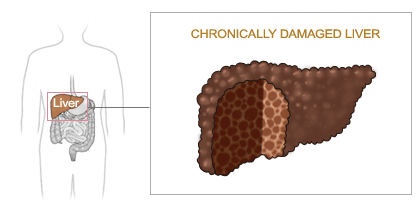The liver is critical to a person’s well-being.
The liver:
- Processes all food and (most) drugs we eat
- Stores iron reserves, as well as vitamins and minerals
- Makes bile to help digest food
- Detoxifies poisonous chemicals, including alcohol and drugs
- Stores energy by stockpiling sugar until needed
- Makes blood (not in adults)
- Manufactures new proteins
- Makes clotting factors to help blood clot
- Removes poisons from the air, exhaust, smoke, and chemicals we breathe
- Hepatitis is an inflammation of the liver
There are several known viruses that cause hepatitis including hepatitis A, B, C, D or E.
Hepatitis A
Sometimes called “infectious hepatitis,” hepatitis A is spread by eating food or drinking water contaminated with human feces. This type of viral hepatitis is not frequently life-threatening and resolve with supportive care.
Hepatitis B
Chronic infection with hepatitis B virus can cause liver cell damage leading to cirrhosis and liver cancer.
How is it Contracted?
Hepatitis B is mainly transmitted through sexual contact, wounds, body secretions, and contaminated needles, and from an infected mother to her newborn.
What Are the Symptoms?
There may be no symptoms. Persons with acute infection may have mild, flu-like symptoms, decreased appetite, nausea, light stools, dark urine, fatigue, fever, or jaundice. Most persons with chronic hepatitis B infection have no symptoms until they develop cirrhosis or liver cancer. The most common symptom of chronic hepatitis B infection is fatigue.
How is it Treated?
Prevention is the best treatment. There is a vaccine for hepatitis B. Hepatitis B vaccine is safe and highly effective. There are five approved treatments for hepatitis B. Standard interferon and pegylated interferon are administered as injections while lamivudine, adefovir and entecavir are administered orally. Two of these treatments were approved by the FDA in 2005: pegylated interferon alfa 2a and entecavir.
How Prevalent is Hepatitis B?
Approximately 70,000 people per year in the US develop acute hepatitis B infection; and roughly 1-1.25 million Americans are chronically infected.
Who is at Risk?
Those who have unprotected sex with infected/multiple partners. Healthcare workers and emergency response personnel who come in contact with blood and blood products. Infants born to infected mothers. Injection drug users.
How Can it be Prevented?
Vaccination. Safe sex. Protective gloves when exposed to blood. Clean up spilled blood with bleach. Do not share razors or toothbrushes. Screening of pregnant women in the US has nearly eliminated newborn infection because at-risk infants receive immunoglobulin and vaccination shortly after birth and are protected. Hepatitis B vaccine is recommended for all newborns, children and adolescents; and adults who are at risk of hepatitis B infection.
Hepatitis C
Hepatitis C is a virus that rarely causes acute illness, but becomes a chronic disease in most infected people. It can lead to cirrhosis and liver cancer.
How is it Contracted?
Hepatitis C is transmitted through contact with infected blood, contaminated needles, or other sharp instruments, and from infected mother to newborn. It is not easily spread through sex. In about 10% of cases, the route of infection is not known.
What are the Symptoms?
Most people with hepatitis C do not feel ill or become sick until 20 years after contracting the virus. Those with long-standing hepatitis may have non-specific symptoms such as fatigue and stomach pains. If hepatitis C progresses to advanced liver disease, patients may develop jaundice, abdominal swelling, internal bleeding or mental confusion (encephalopathy).
How is it Treated?
There is currently no vaccine to prevent hepatitis C. Pegylated interferon with ribavirin is effective in about 50% of those treated.
How Prevalent is Hepatitis C?
Approximately 3-4 million Americans are chronically infected. In addition, there are estimated to be 40,000 new infections per year.
Who is at Risk?
- Persons who ever injected illegal drugs, even once
- Persons with selected medical conditions
- Those receiving clotting factor concentrates before 1987
- Those who were ever on long-term dialysis
- Those with persistently raised liver enzymes
- Prior recipients of transfusions or organ transplants
- Anyone receiving a transfusion prior to 1992
- Persons notified that they had received tainted blood
- Persons receiving an organ transplant prior to 1992
How Can it be Prevented?
Don’t use drugs. Safe sex. Protective gloves when exposed to blood. Clean up spilled blood with bleach. Do not share razors or toothbrushes. Get tested if you are at risk!
Hepatitis D
This form of viral hepatitis is found most often in intravenous (IV) drug users who are also carriers of the hepatitis B virus. Hepatitis D is spread only in the presence of the hepatitis B virus and is transmitted through the same ways. As hepatitis D occurs in people who have viral hepatitis B, it is a serious health problem, and may increase the severity of symptoms associated with hepatitis B.
Hepatitis E
This form of viral hepatitis is similar to viral hepatitis A and is found most often in people who live in countries with poor sanitation. It is rare in North America and rarely life-threatening.
Differences Between Acute and Chronic Hepatitis
Acute hepatitis is the initial infection. Acute hepatitis may be mild or severe. If the infection lasts for six months or longer the condition is called chronic hepatitis. Hepatitis A and E do not cause chronic hepatitis. The hepatitis viruses B, C and D can produce both an acute and chronic episode of illness. Chronic hepatitis B and C are serious health problems.
